
General, Sir Thomas Westropp McMahon Bart., 1871-1892
|
The next occupier of The Sycamores is General Sir Thomas Westropp MacMahon Bart. who is confirmed to live in the house in the 1875 Post Office Directory of Hampshire, Wiltshire & Dorset, and 1878 Kelly's Directory.
This is also confirmed in the 1881 and 1891 censuses as seen below. Sir Thomas Westropp McMahon, third baronet (1813–1892), army officer, born on 14 February 1813, was the eldest son of General Sir Thomas McMahon, second baronet (1779–1860) (The first Baronet was his brother John), who served in the Portuguese army in the Peninsula, and became adjutant-general in India and commander-in-chief at Bombay. His mother was Emily Anne, daughter of Michael Roberts Westropp. His father's elder brother,
Sir John McMahon (c.1754–1817), was private secretary and keeper of the privy purse to the prince regent, afterwards George IV; he became a privy councillor and was created a baronet on 7
August 1817, with remainder in default of his own male issue to McMahon's father, Thomas. |
 |
|
General, Sir Thomas Westropp McMahon in the |

General, Sir Thomas Westropp McMahon
as Commanding Officer of the 5th DG, c1856.(
Credit: BritishEmpire.co.uk )
 On 22 April 1842 he was
transferred as captain to the 9th lancers, and served with it, under the command of Sir James Hope Grant, in India
during the Sutlej campaign and at the
battle of Sobraon on 10 February 1846. He was promoted to a majority unattached on 13 July 1847.
On 22 April 1842 he was
transferred as captain to the 9th lancers, and served with it, under the command of Sir James Hope Grant, in India
during the Sutlej campaign and at the
battle of Sobraon on 10 February 1846. He was promoted to a majority unattached on 13 July 1847.

The Times ©,
Saturday, Apr 23, 1842
1851: McMahon first married on 7 October 1851, Dora Paulina (d. 23 Sept 1852) who we believe died in child birth.

The Morning Chronicle, Thursday, October 9, 1851
1855: He served in Turkey and the Crimea as assistant quartermaster-general of the cavalry division, and was present at the battles of the Alma, Balaclava, and the Chernaya, and at the siege of Sevasopol. He was created CB (5 July 1855) and the fifth class of the Mejidiye.
McMahon is mentioned in A W Kinglake's 1860s Invasion of the Crimea Volume V, page 290 [Credit: Aldershot library]:
"In his own person - and the keenness of his far-reaching sight made him apt for this service - Lord Lucan strove hard to prolong the connection between his two brigades by riding on in advance of his Heavy Dragoons, and following his Light Cavalry with straining eyes; but he-had not long passed the Number Four Redoubt when he was rudely compelled to perceive that he had entered on the path of destruction already traversed by his Light Cavalry, and was drawing forward his Heavy Dragoons to the verge of a like disaster.
His aide-de-camp, Captain Charteris - fulfilling an incurable presentiment - fell dead at his side; Lord William Paulet, his Assistant-Adjutant-General, was struck, or unbonneted by a shot or a shell; Major M’Mahon, his Assistant-Quartermaster-General (not, however, at quite the same time), had his horse struck by grape; and Lord Lucan himself was wounded in the leg by a musket-ball, his horse being also struck in two places."
Below is an extract from a letter by General Lord Paget at Balaclava:
"The conversation which ensued will ever be vividly impressed on my memory. "Holloa," said Lord William, "there are two flags flying what does that mean?" "Why, that surely is the signal that the enemy is approaching," said Major McMahon. "Are you quite sure?" we replied. We were not long kept in doubt! Hardly were the words out of McMahon's mouth, when bang went a cannon from the redoubt in question, fired on the advancing masses of the enemy. Off scampered my two companions to their chief, while, I turned round and galloped back "best pace" to my brigade..." [Source: Extracts from the Letters and Journal of General Lord George Paget]
Below is an extract from a letter by Lord Cardigan in 1866 concerning the 'charge of the Light Brigade' at balaclava which he led [Background to the letters]:
"Dear Mr Kinglake, I feel extremely obliged to you for your letter of the 3d. inst. and particularly for your kind reference to Captn. Chadwick's letter of praise of the conduct of the Leader of the Light Brigade in the charge of Balaklava...
...There can be no doubt that the statement on oath by him viz that when I returned from the charge I was 200 yards from him is a false and perjured statement by the evidence of myself Gen. Scarlett - Sir Thos. McMahon & Lord Wm. Paulet's verbal statement to De Burgh which has been taken down in writing. If I can obtain any more information I will write. [Source: Letters by Lord Cardigan]
Dear Sir
Very faithfully Yrs
Cardigan"
An excellent overview of the charge of the Light Brigade can be read here.
While in the Crimea, on the promotion of Sir James Yorke Scarlett, mentioned above, (Note: Sir James Scarlett lived in Forest
lodge
![]() in Farnborough for a time), he
became lieutenant-colonel in the
5th Dragoon Guards from 12 December 1854, and commanded that regiment until he went on half pay in 1861 (Note: Half
pay is a retainer paid to officers who remain available for future service).
in Farnborough for a time), he
became lieutenant-colonel in the
5th Dragoon Guards from 12 December 1854, and commanded that regiment until he went on half pay in 1861 (Note: Half
pay is a retainer paid to officers who remain available for future service).
1859: McMahon married again on 13 January 1859, Frances Mary (d. 14 April 1867).

The Morning Chronicle, Monday, January 17, 1859;
Frances is buried with her husband according to the cemetery records, but this is not reflected on the memorial engravings. With his second wife he had four sons, who all entered the army, and one daughter. Her daughter was named after her.
1860: He succeeded his father as third Baronet in 1860. The line of military McMahons continues to the present day, to the 8th Baronet.
1869: He became a major-general on 6 March 1869:

The Times ©,
Wednesday, Oct 20, 1869
He commanded the cavalry brigade at Aldershot and was inspector-general of cavalry from 1871 to 1876, and became lieutenant-general in 1877 and general in 1880. On 1st June 1874 he received the honorary colonelcy 18th hussars.
1871: General Sir Thomas MacMahon buys The Sycamores.
1881: General Sir MacMahon 68 lives in the house with fourteen domestic servants. William Brown 48 is the coachman and he lives with his tow sons in "rooms over stables".

1881 census for Sycamore House
[Credit: Hampshire Record Office]
1885: In 1885 Sir McMahon became the Colonel of the 5th Dragoon Guards until his death in 1892 (Museum of The Royal Dragoon Guard).

The Times ©,
Saturday, Mar 28, 1885
Note: McMahon's compatriot in the 18th hussars and 5th Dragoon Guards, General Sir James Yorke Scarlett (died 1871) lived at Forest Lodge, another of the early houses located in Farnborough. We believe General McMahon's 3rd son was named after him, Francis Yorke McMahon.
1888: McMahon married again on 14 August 1888, Constance Marianne (d. 19 Sept 1893).

The Pall Mall Gazette, Wednesday, August 15, 1888
c1890: Around 1890, The Sycamores is mentioned in the "The memoirs of Farnborough" which is held in the Farnborough Library. These were written by H. A. Bartlett about sixty years later. They mention the Lodge and the large iron gates to the entrance of The Sycamores.

1891: General MacMahon 78 still lives in the house and seemed to have lived alone with nine domestic servants. There is no mention of his wife Constance. It turns out that Constance McMahon was listed as being head of the household and living with her daughter Nellie at 40 Queensgate in London in the 1891 census. She was listed as "Living on her own means".

1891 census for Sycamore House and Sycamore Lodge
[Credit: Hampshire Record Office]
1892: General Sir Thomas Westropp MacMahon C.B died on January 25th 1892 aged 78.
Monday January 25th 1892 |
Sheldrake's Aldershot & Sandhurst Military Gazette January 30th 1892 |
 |
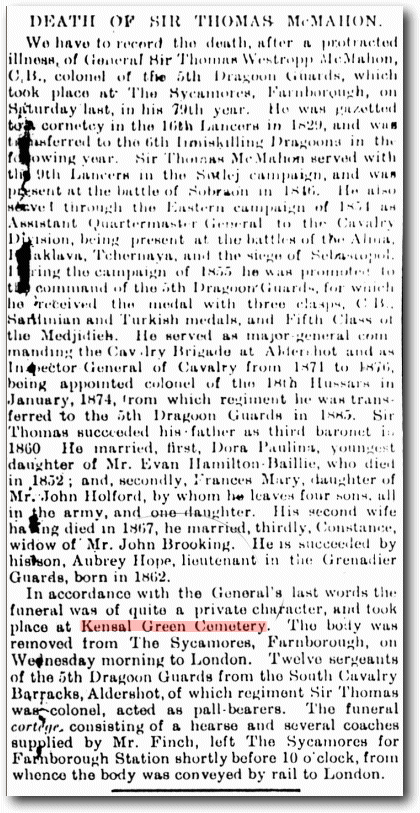 |

The Graphic, Saturday, January 30, 1892

The Pall Mall Gazette (London, England), Monday, March 7, 1892
Note: It was pleasing to see that the Sheldrake obituary, although the same as the one in The Times ©, contained details of Sir Thomas's burial place enabling us to take a photograph.
Sir Thomas's grave in Kensal Green Cemetery in London
![]() .
.
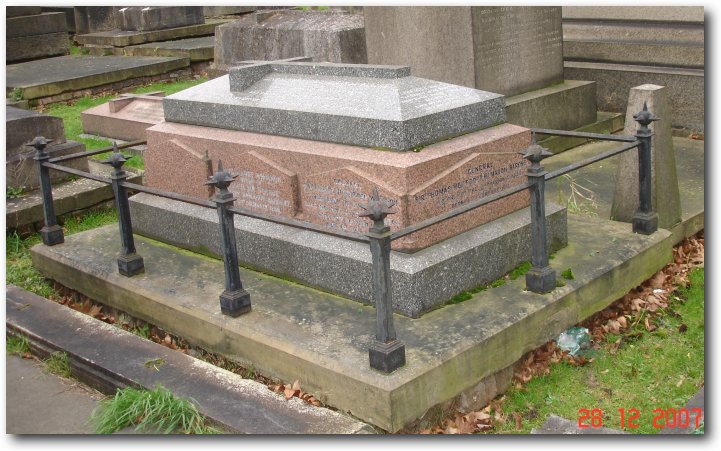
The family grave in Kensal Green Cemetery in London
![]()
The following three generations of the family are interred:
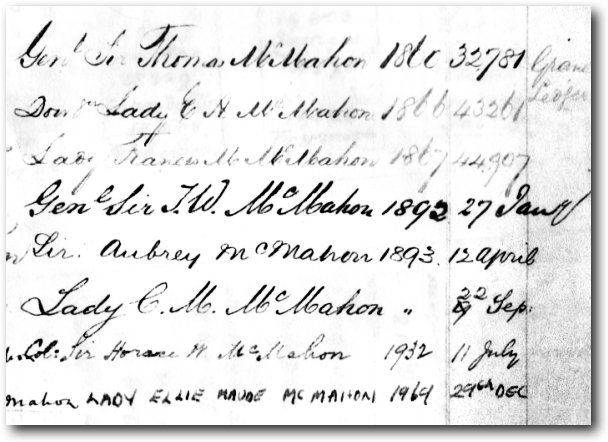
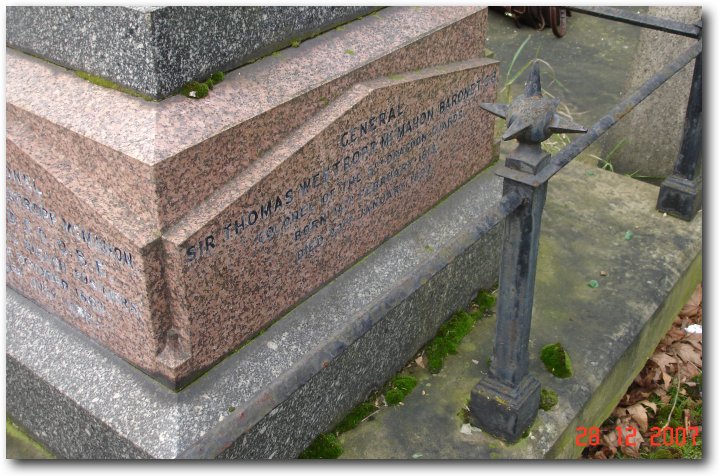
Sir Thomas's 1992 inscription in Kensal Green Cemetery in London
![]()
1892: The Sycamores was sold to General Sir Reginald Gipps KCB
1893: In 1893, his wife Constance died aged 48 on 19 September while living in Kensington.

The Times ©,
Friday, Sep 22, 1893
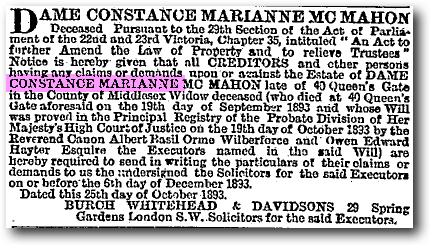
The Times ©,
Thursday, Oct 26, 1893
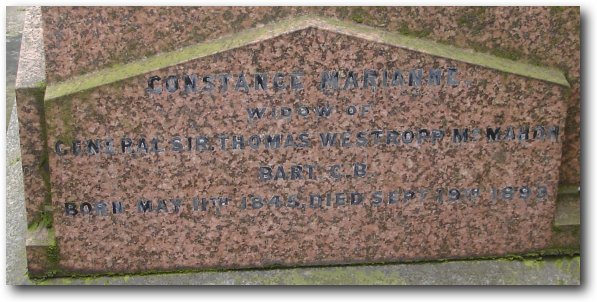
Constance's grave in Kensal Green Cemetery in London
![]()
1896: In 1896 there was a sale of General MacMahon's artwork. (Source: Hampshire Records Office: Sale catalogue of works of art of Gen. Sir Thomas MacMahon et al. 19 December 1896 - 63M84/233/p61a).
